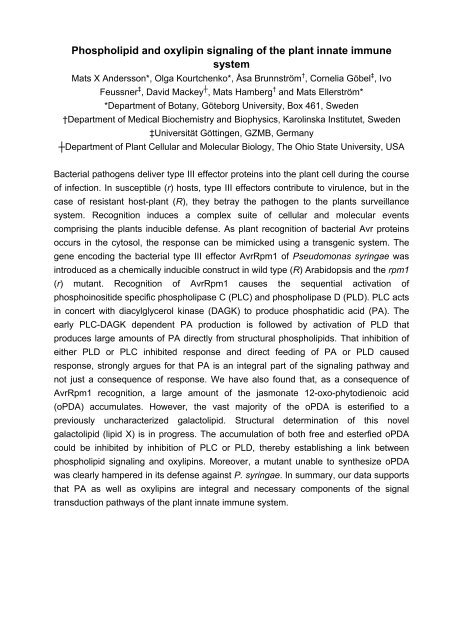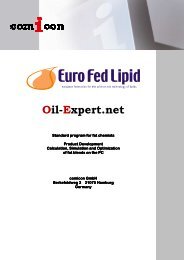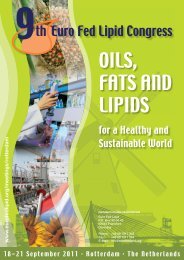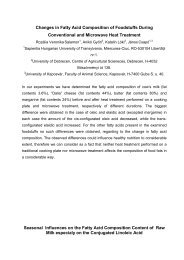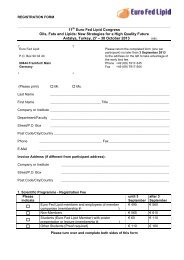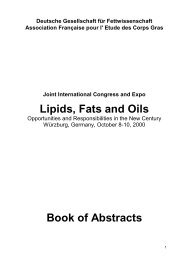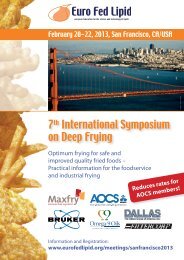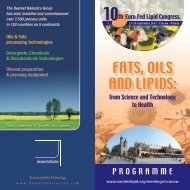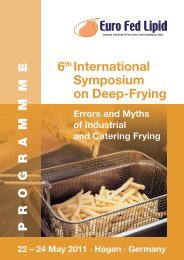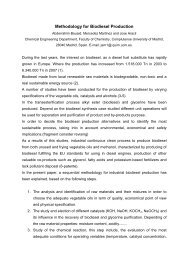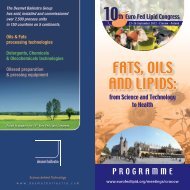Abstracts now available online - Euro Fed Lipid
Abstracts now available online - Euro Fed Lipid
Abstracts now available online - Euro Fed Lipid
Create successful ePaper yourself
Turn your PDF publications into a flip-book with our unique Google optimized e-Paper software.
Phospholipid and oxylipin signaling of the plant innate immune<br />
system<br />
Mats X Andersson*, Olga Kourtchenko*, Åsa Brunnström † , Cornelia Göbel ‡ , Ivo<br />
Feussner ‡ , David Mackey ┼ , Mats Hamberg † and Mats Ellerström*<br />
*Department of Botany, Göteborg University, Box 461, Sweden<br />
†Department of Medical Biochemistry and Biophysics, Karolinska Institutet, Sweden<br />
‡Universität Göttingen, GZMB, Germany<br />
┼Department of Plant Cellular and Molecular Biology, The Ohio State University, USA<br />
Bacterial pathogens deliver type III effector proteins into the plant cell during the course<br />
of infection. In susceptible (r) hosts, type III effectors contribute to virulence, but in the<br />
case of resistant host-plant (R), they betray the pathogen to the plants surveillance<br />
system. Recognition induces a complex suite of cellular and molecular events<br />
comprising the plants inducible defense. As plant recognition of bacterial Avr proteins<br />
occurs in the cytosol, the response can be mimicked using a transgenic system. The<br />
gene encoding the bacterial type III effector AvrRpm1 of Pseudomonas syringae was<br />
introduced as a chemically inducible construct in wild type (R) Arabidopsis and the rpm1<br />
(r) mutant. Recognition of AvrRpm1 causes the sequential activation of<br />
phosphoinositide specific phospholipase C (PLC) and phospholipase D (PLD). PLC acts<br />
in concert with diacylglycerol kinase (DAGK) to produce phosphatidic acid (PA). The<br />
early PLC-DAGK dependent PA production is followed by activation of PLD that<br />
produces large amounts of PA directly from structural phospholipids. That inhibition of<br />
either PLD or PLC inhibited response and direct feeding of PA or PLD caused<br />
response, strongly argues for that PA is an integral part of the signaling pathway and<br />
not just a consequence of response. We have also found that, as a consequence of<br />
AvrRpm1 recognition, a large amount of the jasmonate 12-oxo-phytodienoic acid<br />
(oPDA) accumulates. However, the vast majority of the oPDA is esterified to a<br />
previously uncharacterized galactolipid. Structural determination of this novel<br />
galactolipid (lipid X) is in progress. The accumulation of both free and esterfied oPDA<br />
could be inhibited by inhibition of PLC or PLD, thereby establishing a link between<br />
phospholipid signaling and oxylipins. Moreover, a mutant unable to synthesize oPDA<br />
was clearly hampered in its defense against P. syringae. In summary, our data supports<br />
that PA as well as oxylipins are integral and necessary components of the signal<br />
transduction pathways of the plant innate immune system.


